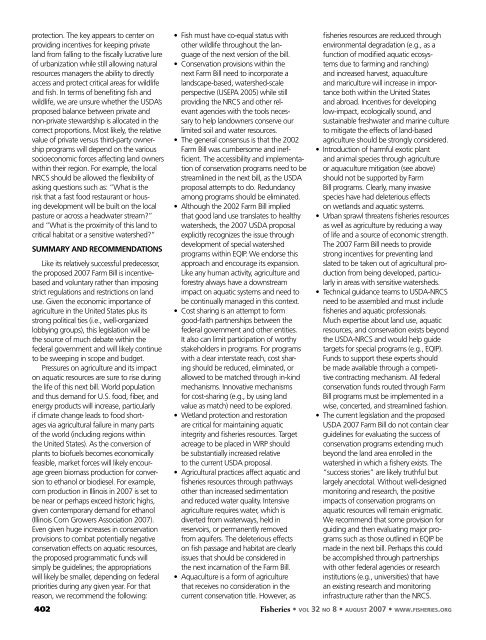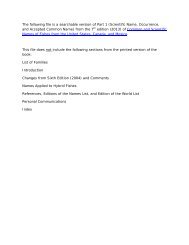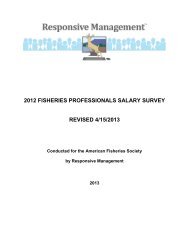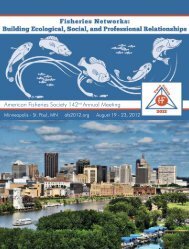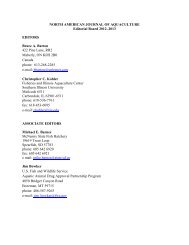Conservation Status of Crayfish Species Paddlefish Conservation ...
Conservation Status of Crayfish Species Paddlefish Conservation ...
Conservation Status of Crayfish Species Paddlefish Conservation ...
You also want an ePaper? Increase the reach of your titles
YUMPU automatically turns print PDFs into web optimized ePapers that Google loves.
protection. The key appears to center on<br />
providing incentives for keeping private<br />
land from falling to the fiscally lucrative lure<br />
<strong>of</strong> urbanization while still allowing natural<br />
resources managers the ability to directly<br />
access and protect critical areas for wildlife<br />
and fish. In terms <strong>of</strong> benefiting fish and<br />
wildlife, we are unsure whether the uSdA’s<br />
proposed balance between private and<br />
non-private stewardship is allocated in the<br />
correct proportions. Most likely, the relative<br />
value <strong>of</strong> private versus third-party ownership<br />
programs will depend on the various<br />
socioeconomic forces affecting land owners<br />
within their region. For example, the local<br />
NRcS should be allowed the flexibility <strong>of</strong><br />
asking questions such as: “What is the<br />
risk that a fast food restaurant or housing<br />
development will be built on the local<br />
pasture or across a headwater stream?”<br />
and “What is the proximity <strong>of</strong> this land to<br />
critical habitat or a sensitive watershed?”<br />
SUmmAry ANd reCommeNdAtioNS<br />
like its relatively successful predecessor,<br />
the proposed 2007 Farm Bill is incentivebased<br />
and voluntary rather than imposing<br />
strict regulations and restrictions on land<br />
use. Given the economic importance <strong>of</strong><br />
agriculture in the united States plus its<br />
strong political ties (i.e., well-organized<br />
lobbying groups), this legislation will be<br />
the source <strong>of</strong> much debate within the<br />
federal government and will likely continue<br />
to be sweeping in scope and budget.<br />
pressures on agriculture and its impact<br />
on aquatic resources are sure to rise during<br />
the life <strong>of</strong> this next bill. World population<br />
and thus demand for u.S. food, fiber, and<br />
energy products will increase, particularly<br />
if climate change leads to food shortages<br />
via agricultural failure in many parts<br />
<strong>of</strong> the world (including regions within<br />
the united States). As the conversion <strong>of</strong><br />
plants to bi<strong>of</strong>uels becomes economically<br />
feasible, market forces will likely encourage<br />
green biomass production for conversion<br />
to ethanol or biodiesel. For example,<br />
corn production in Illinois in 2007 is set to<br />
be near or perhaps exceed historic highs,<br />
given contemporary demand for ethanol<br />
(Illinois corn Growers Association 2007).<br />
even given huge increases in conservation<br />
provisions to combat potentially negative<br />
conservation effects on aquatic resources,<br />
the proposed programmatic funds will<br />
simply be guidelines; the appropriations<br />
will likely be smaller, depending on federal<br />
priorities during any given year. For that<br />
reason, we recommend the following:<br />
• Fish must have co-equal status with<br />
other wildlife throughout the language<br />
<strong>of</strong> the next version <strong>of</strong> the bill.<br />
• conservation provisions within the<br />
next Farm Bill need to incorporate a<br />
landscape-based, watershed-scale<br />
perspective (uSepA 2005) while still<br />
providing the NRcS and other relevant<br />
agencies with the tools necessary<br />
to help landowners conserve our<br />
limited soil and water resources.<br />
• The general consensus is that the 2002<br />
Farm Bill was cumbersome and inefficient.<br />
The accessibility and implementation<br />
<strong>of</strong> conservation programs need to be<br />
streamlined in the next bill, as the uSdA<br />
proposal attempts to do. Redundancy<br />
among programs should be eliminated.<br />
• Although the 2002 Farm Bill implied<br />
that good land use translates to healthy<br />
watersheds, the 2007 uSdA proposal<br />
explicitly recognizes the issue through<br />
development <strong>of</strong> special watershed<br />
programs within eQIp. We endorse this<br />
approach and encourage its expansion.<br />
like any human activity, agriculture and<br />
forestry always have a downstream<br />
impact on aquatic systems and need to<br />
be continually managed in this context.<br />
• cost sharing is an attempt to form<br />
good-faith partnerships between the<br />
federal government and other entities.<br />
It also can limit participation <strong>of</strong> worthy<br />
stakeholders in programs. For programs<br />
with a clear interstate reach, cost sharing<br />
should be reduced, eliminated, or<br />
allowed to be matched through in-kind<br />
mechanisms. Innovative mechanisms<br />
for cost-sharing (e.g., by using land<br />
value as match) need to be explored.<br />
• Wetland protection and restoration<br />
are critical for maintaining aquatic<br />
integrity and fisheries resources. Target<br />
acreage to be placed in WRp should<br />
be substantially increased relative<br />
to the current uSdA proposal.<br />
• Agricultural practices affect aquatic and<br />
fisheries resources through pathways<br />
other than increased sedimentation<br />
and reduced water quality. Intensive<br />
agriculture requires water, which is<br />
diverted from waterways, held in<br />
reservoirs, or permanently removed<br />
from aquifers. The deleterious effects<br />
on fish passage and habitat are clearly<br />
issues that should be considered in<br />
the next incarnation <strong>of</strong> the Farm Bill.<br />
• Aquaculture is a form <strong>of</strong> agriculture<br />
that receives no consideration in the<br />
current conservation title. However, as<br />
fisheries resources are reduced through<br />
environmental degradation (e.g., as a<br />
function <strong>of</strong> modified aquatic ecosystems<br />
due to farming and ranching)<br />
and increased harvest, aquaculture<br />
and mariculture will increase in importance<br />
both within the united States<br />
and abroad. Incentives for developing<br />
low-impact, ecologically sound, and<br />
sustainable freshwater and marine culture<br />
to mitigate the effects <strong>of</strong> land-based<br />
agriculture should be strongly considered.<br />
• Introduction <strong>of</strong> harmful exotic plant<br />
and animal species through agriculture<br />
or aquaculture mitigation (see above)<br />
should not be supported by Farm<br />
Bill programs. clearly, many invasive<br />
species have had deleterious effects<br />
on wetlands and aquatic systems.<br />
• urban sprawl threatens fisheries resources<br />
as well as agriculture by reducing a way<br />
<strong>of</strong> life and a source <strong>of</strong> economic strength.<br />
The 2007 Farm Bill needs to provide<br />
strong incentives for preventing land<br />
slated to be taken out <strong>of</strong> agricultural production<br />
from being developed, particularly<br />
in areas with sensitive watersheds.<br />
• Technical guidance teams to uSdA-NRcS<br />
need to be assembled and must include<br />
fisheries and aquatic pr<strong>of</strong>essionals.<br />
Much expertise about land use, aquatic<br />
resources, and conservation exists beyond<br />
the uSdA-NRcS and would help guide<br />
targets for special programs (e.g., eQIp).<br />
Funds to support these experts should<br />
be made available through a competitive<br />
contracting mechanism. All federal<br />
conservation funds routed through Farm<br />
Bill programs must be implemented in a<br />
wise, concerted, and streamlined fashion.<br />
• The current legislation and the proposed<br />
uSdA 2007 Farm Bill do not contain clear<br />
guidelines for evaluating the success <strong>of</strong><br />
conservation programs extending much<br />
beyond the land area enrolled in the<br />
watershed in which a fishery exists. The<br />
“success stories” are likely truthful but<br />
largely anecdotal. Without well-designed<br />
monitoring and research, the positive<br />
impacts <strong>of</strong> conservation programs on<br />
aquatic resources will remain enigmatic.<br />
We recommend that some provision for<br />
guiding and then evaluating major programs<br />
such as those outlined in eQIp be<br />
made in the next bill. perhaps this could<br />
be accomplished through partnerships<br />
with other federal agencies or research<br />
institutions (e.g., universities) that have<br />
an existing research and monitoring<br />
infrastructure rather than the NRcS.<br />
402 Fisheries • vol 32 no 8 • august 2007 • www.fisheries.org


